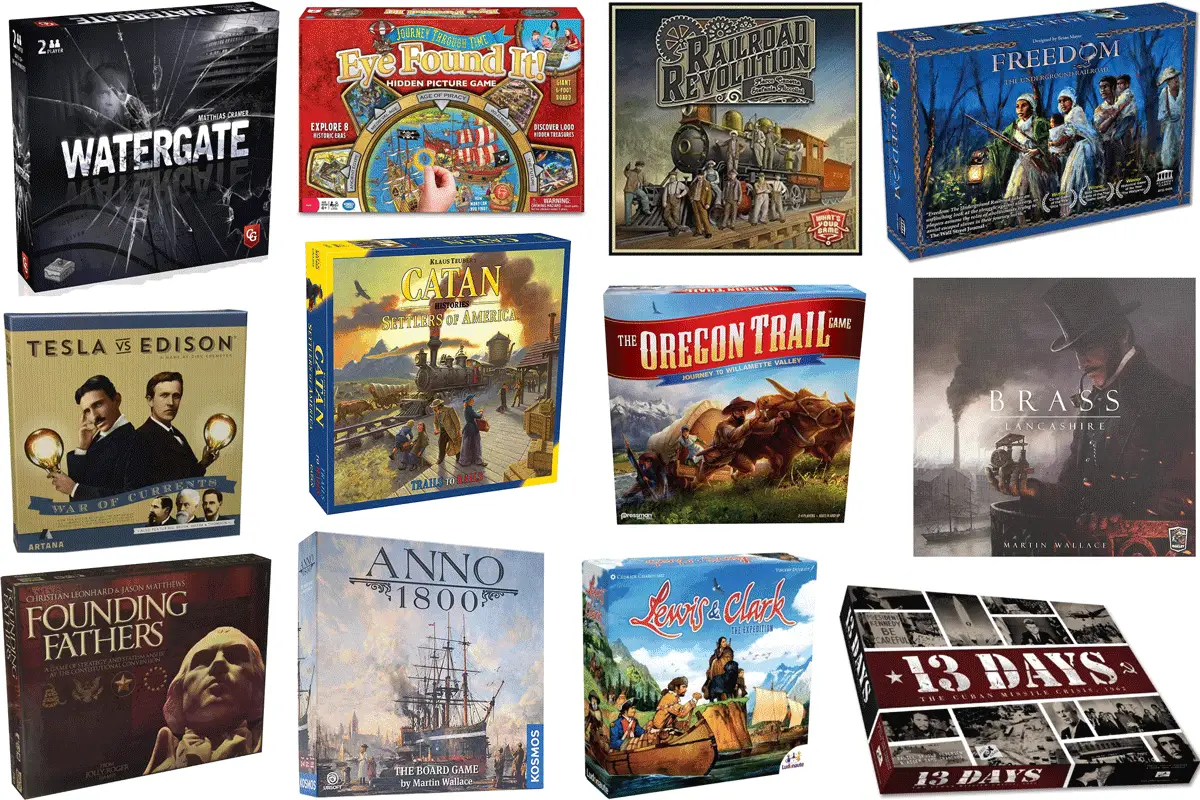This post contains affiliate links.
The 17th to the 20th Century period is extremely rich and relatable for kids. History-themed games about this period are not “educational games” of course, but they do remind us of important historical events and create curiosity around their historical context. Among the 12 I have identified, I can mention:
- 2 player games such as “13 Days: The Cuban Missile Crisis” and “Watergate” for the 20th century.
- Multiplayer games like Brass and Freedom: The Underground Railroad put players in the context of the Industrial Revolution and the abolitionist movement, respectively.
Modern History-themed Board Games Comparison Table
| Game | Theme | Type | Age | Players | Price | Rating |
|---|---|---|---|---|---|---|
| 13 Days: The Cuban Missile Crisis | Cold War | Bluff & Strategy | 10+ | 2 | $$$ | ★★★★☆ |
| Watergate | President Nixon’s political scandal | Strategy | 12+ | 2 | $$$ | ★★★★★ |
| Anno 1800 | Industrial Age | Civilization-building | 12+ | 2‑4 | $$$$$ | ★★★★☆ |
| Brass | Industrial Revolution | Economic Strategy | 14+ | 2-4 | $$$$ | ★★★★☆ |
| Lewis & Clark | American West Exploration | Race | 10+ | 1‑5 | $$$$ | ★★★☆☆ |
| The Oregon Trail | American West Exploration | Race | 13+ | 2‑4 | $$$ | ★★★★☆ |
| Railroad Revolution | Trains in the 19th Century | Worker placement | 12+ | 2‑4 | $$$ | ★★★☆☆ |
| Tesla Vs. Edison | War of the Currents | Economic strategy | 14+ | 2-5 | $$$ | ★★★☆☆ |
| Catan Histories: Settlers of America | 19th Century American Settlement | Civilization Exploration | 12+ | 3‑4 | $$$$ | ★★★☆☆ |
| Founding Fathers | Making of the US Constitution | Strategy | 13+ | 3-5 | $$$ | ★★★☆☆ |
| We the People Fight the Tyranny | Founding History of the US | Roll, Spin and Move Trivia | 15+ | 3‑8 | $$$$ | ★★★☆☆ |
| Freedom: The Underground Railroad | American Civil War | Economic/ Political Strategy | 13+ | 1‑4 | $$$$ | ★★★★☆ |
History-themed Strategy Board Games with 2 Players
13 Days- The Cuban Missile Crisis (Ultra PRO Sports)
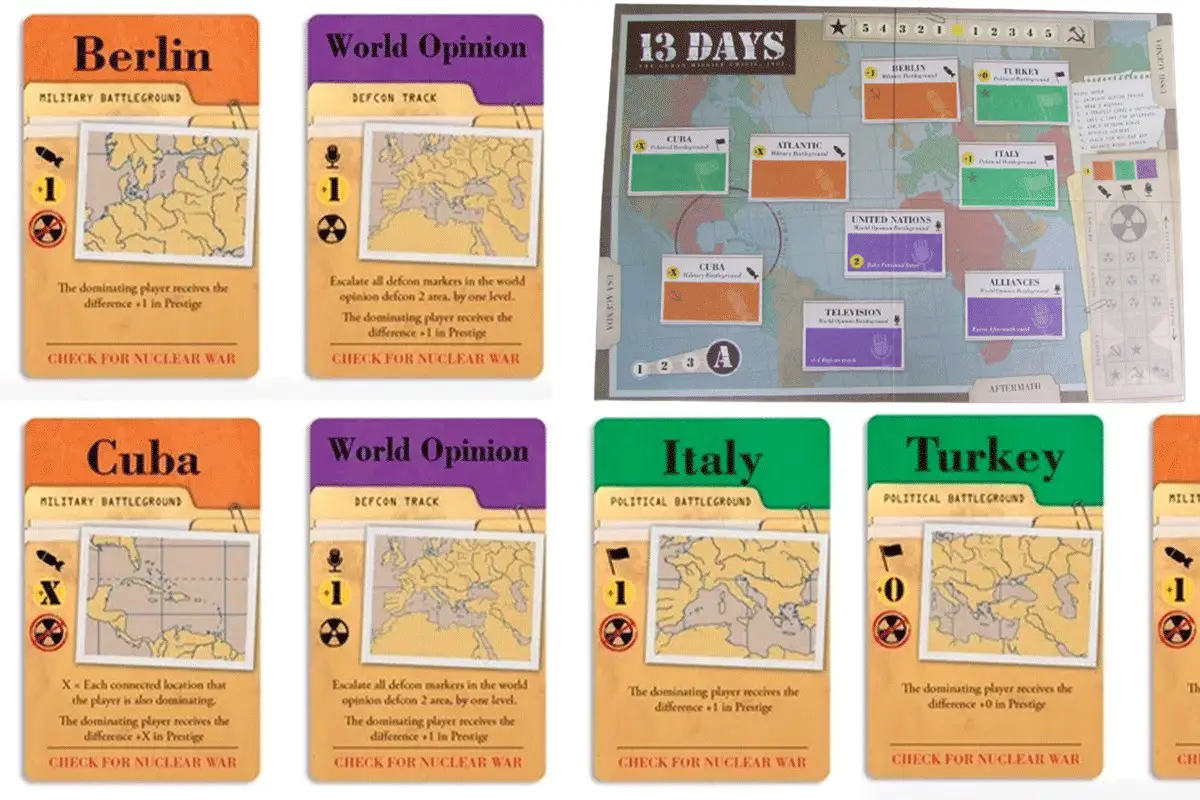
★★★★★
Age: 10+ | 2 Players | Game Duration: 30-45 minutes | Authors: Asger Harding Granerud and Daniel Skjold Pedersen
One of my go-to games for teaching children about the Cold War is the two-player war simulation game, 13 Days-The Cuban Missile Crisis.
It is a card-driven game that accurately depicts the thirteen-day political and military tension between the Soviet Union and the United States in 1962. This conflict stemmed from installing nuclear-armed Soviet missiles in Cuba, 90 miles away from the US.
Players represent US President John F. Kennedy or the USSR Premier Nikita Khrushchev and try their hand at solving the crisis.
The game is played over three rounds. Players have a hand of four cards in each round.
The gameboard contains a Defcon track divided into three sections with three rows, each representing events for military, political, and world opinion.
The main goal is not to trigger a nuclear war. Both players must carefully strategize to activate the event cards and avoid reaching DefCon 1 section on the gameboard. Otherwise, the player automatically loses.
Ironically, this game has more ways to lose than win. Both players lose the game if a player has three markers on Def Con section 2. This space is marked with nuclear symbols.
I highly recommend this game because
- It is really educational
- It has a historical guide booklet
- The cards contain actual images and short explanations at the bottom
- the rules are easy to learn
- It can be played even without background knowledge of the historical events.
- This game is shorter to play than Twilight Struggle (it takes less than an hour to finish the game)
- It is deep in strategy but not boring.
Game contents include 53 cards, 48 color-coded wood markers, flags, and a rulebook.
by Gameboygeek
Watergate (Capstone Games)
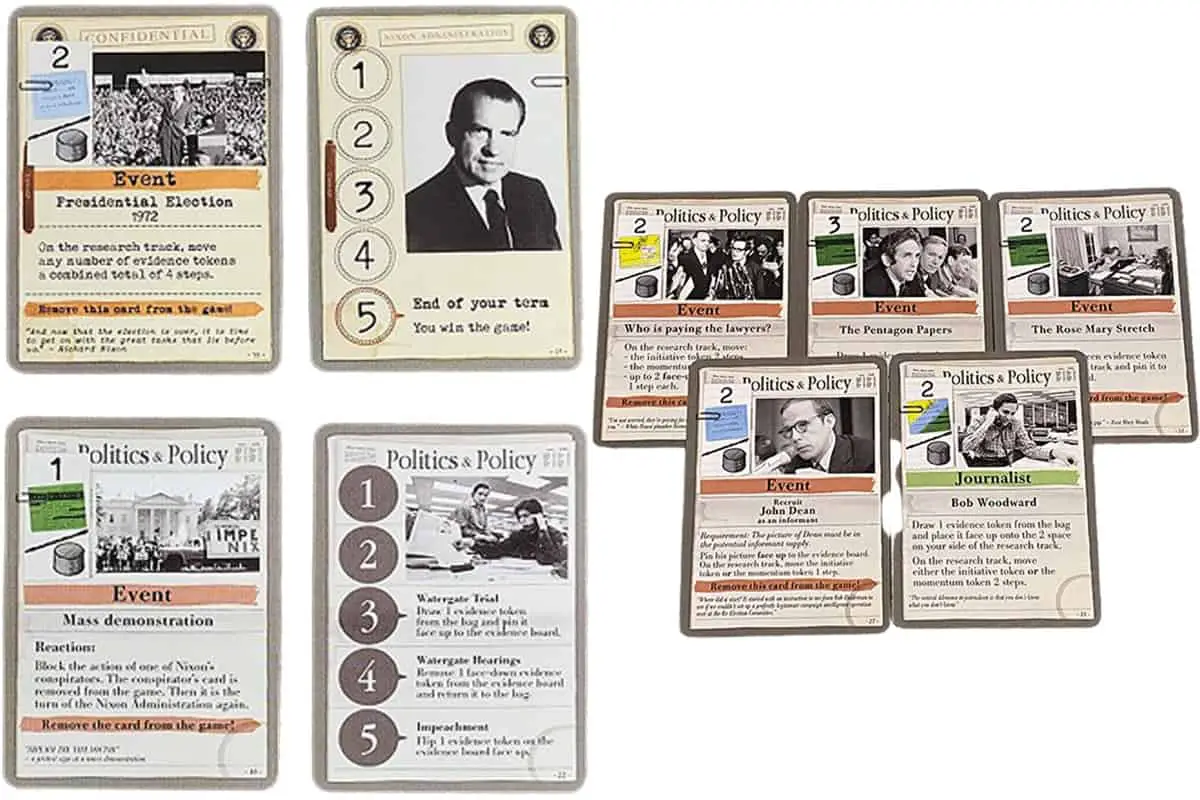
★★★★★
Age: 14+ | 2 Players | Game Duration: 30-45 minutes | Author: Matthias Cramer
If your child is interested in the journalistic way of investigating historic events or political scandals, Watergate is a great practice game.
is a great practice game.
It contains 40 cards based on actual events that exposed the secrets of US President Richard Nixon and his administration surrounding the arrest of five men at Washington’s Watergate building in 1972.
This incident triggered two journalists, Bob Woodward and Carl Bernstein, to investigate further, and they found out that the five men were sent by the White House to spy on political opponents. Thus, in 1974 President Nixon resigned to avoid impeachment.
In this card-driven game, players represent the embattled president or the journalist. They take turns triggering events or pushing action points that either bury the truth or force the president to end his term.
Ways to win in the game:
- The journalist wins the game immediately if the player manages to connect 2 informants to Nixon through an uninterrupted line of evidence (Nixon cards can block this trail of evidence)
- Nixon wins if the player succeeds in collecting 5 momentum tokens (this enables Nixon to ride out his presidential term)
The rules are complicated at first because there are many details to remember, but as soon as you figure out how the pieces work together, the game flows smoothly. Other game components are a gameboard, tokens, picture tiles, and a bag.
I am giving this two-player game a five-star rating because
- Even if the player is not interested in history, it is nicely embedded in the gameplay
- The tiles and cards contain real images of important people and incidents
- The rulebook contains background information about the events and the people involved in the scandal
- The components are stimulating.
- It is a short game (takes about 30-45 minutes to play)
- The replay value is high because the game is unpredictable (players can switch roles and get a different experience because of luck in playing cards and tokens)
This game is suitable for high school students.
shows how to play Watergate
Multi-player History-themed Strategy Board Games
Anno 1800 (Thames and Kosmos)
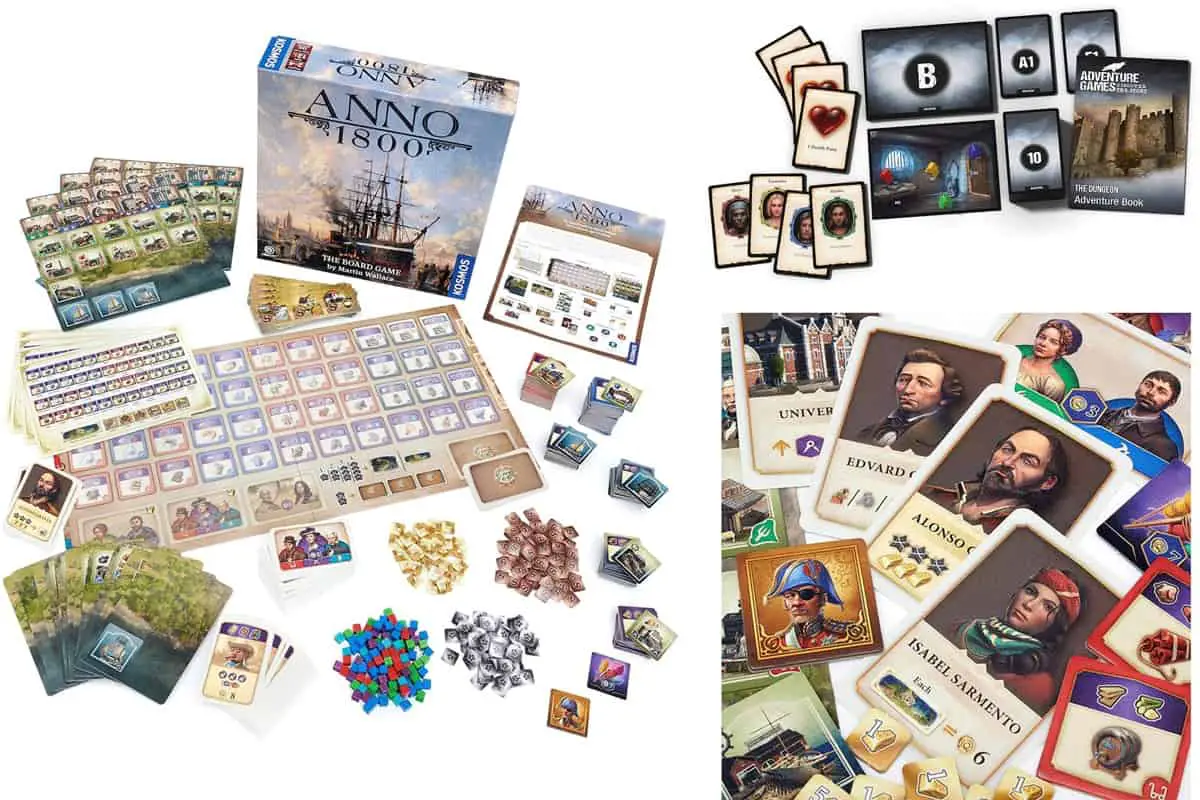
★★★★☆
Age: 10+ | 2-4 Players | Game Duration: 1-2 hours | Author: Martin Wallace
Anno 1800 is a civilization-building game that features the development of industries during the Industrial Age. It was inspired by the PC game created by Ubisoft.
is a civilization-building game that features the development of industries during the Industrial Age. It was inspired by the PC game created by Ubisoft.
The player’s goal is to turn his home island into the most prosperous island at the end of the game.
At the start of the game, each player receives a personal island board, a set of nine population cubes, and a deck of nine population cards that contain the needs of the island people. In each turn, a player can choose one action out of nine options that include:
- collect resources to develop engines and activate industries,
- increase population by making them happy with basic and luxury goods,
- distribute the population or workforce according to their specialization (farmers, workers, artisans, engineers, and investors)
- Trading
- Explore the old and new world through expeditions
- Reinvigorate the workforce by holding a festival
The game is over as soon as a player fulfilled his last population card.
Anno 1800 is a really good game if you love civilization-building games, but is rather complex and takes time to setup. It has great game mechanics but there is not any specific educational value regarding the theme (the industrial revolution).
is a really good game if you love civilization-building games, but is rather complex and takes time to setup. It has great game mechanics but there is not any specific educational value regarding the theme (the industrial revolution).
Brass (Roxley Games)
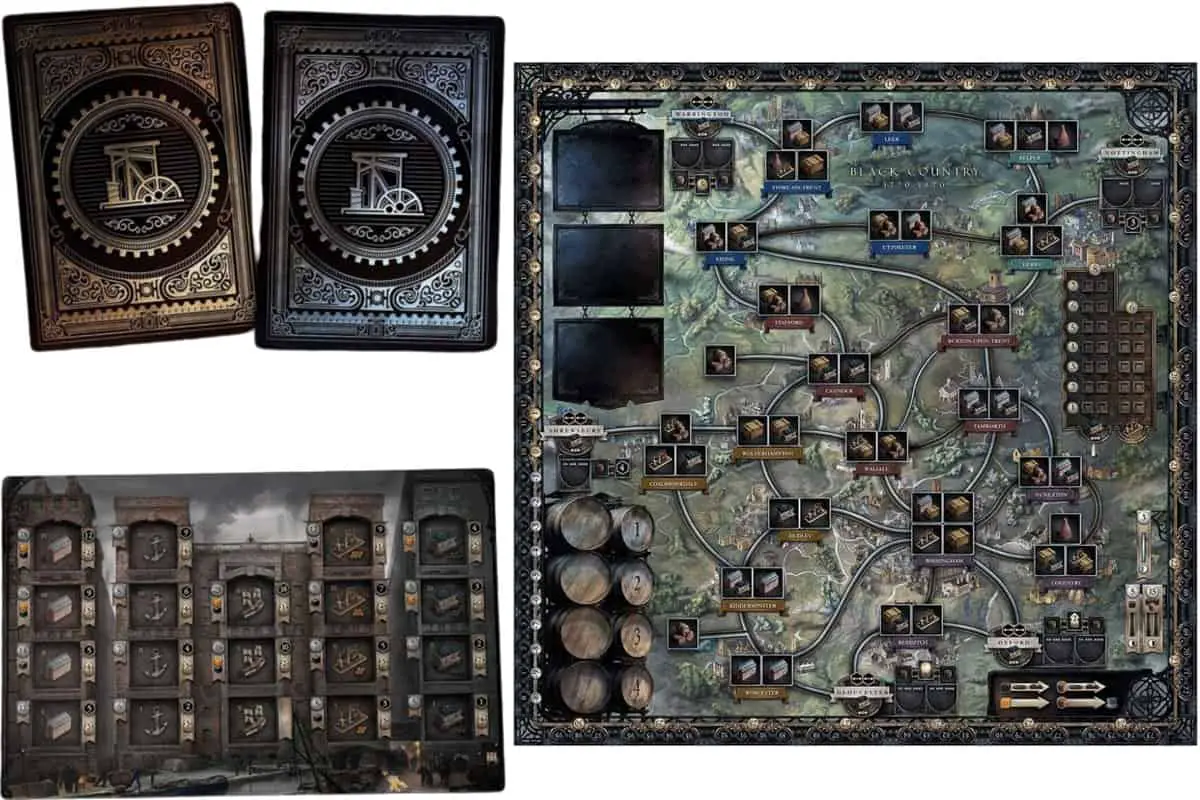
★★★★☆
Age: 14+ | 2-4 Players | Game Duration: 1-2 hours | Author: Martin Wallace
Brass Lancashire is an economic strategy game created by the same author Martin Wallace.
is an economic strategy game created by the same author Martin Wallace.
Players take on the role of entrepreneurs in Lancashire, England, during the Industrial Revolution. They compete in building mines, cotton factories, and connections to take advantage of the demand for iron, coal, and cotton. However, the cards they draw limit the location where they can set up these industries and networks.
This game is played over two historical periods. Players build canals in the first phase, but they remove these canals and all level 1 buildings to build rails in the second half.
Victory points are earned from building canals, rails, and flipping industry tiles. The player who obtains the highest victory points wins the game. These points are counted at the end of each phase.
I like that players can optimize their turns, and that both phases are deep in strategy, where players focus the first half on increasing income to outbuild the opponent in the second half.
It does not particularly add educational value through the theme, but the game itself is great.
gives a great game overview of Brass.
Lewis and Clark (Ludonaute)
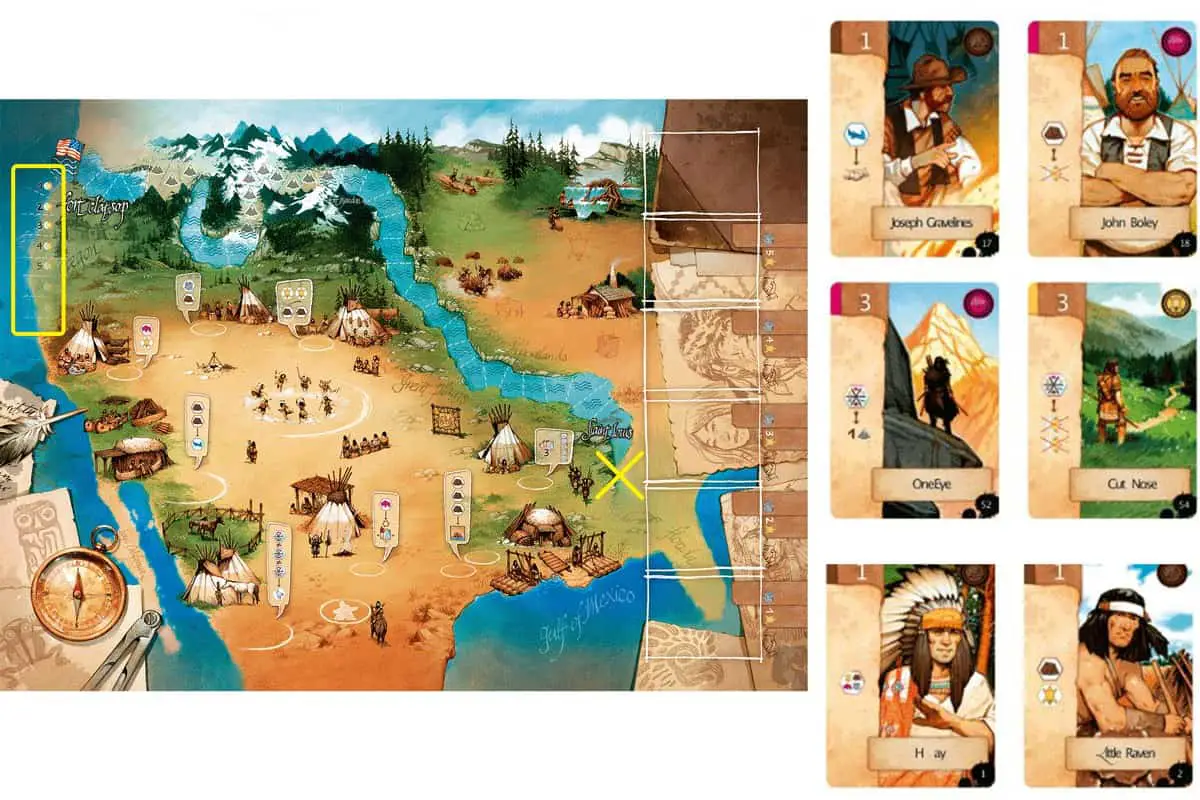
★★★☆☆
Age: 10+ | 1-5 Players | Game Duration: 1-2 hours | Author: Cedrick Chaboussit
Lewis and Clark is a strategy game inspired by Lewis & Clark Expedition from 1803 to 1806. In 1803, President Thomas Jefferson commissioned Captain Meriwether Lewis and Second Lieutenant William Clark to explore the newly acquired western portion of the United States after purchasing Louisiana from Napoleon.
is a strategy game inspired by Lewis & Clark Expedition from 1803 to 1806. In 1803, President Thomas Jefferson commissioned Captain Meriwether Lewis and Second Lieutenant William Clark to explore the newly acquired western portion of the United States after purchasing Louisiana from Napoleon.
In this game, players assume the roles of the two explorers and compete in reaching the Pacific first. Each player has their own crew called Corps of Discovery that will be filled by the Native Americans and trappers met during the expedition.
Lewis & Clark is a very beautiful game, but quite complex, long to play and slow. From an educational point of view there is not really any theme-related content.
how to play Lewis & Clark
The Oregon Trail: Journey to Willamette Valley (Pressman)
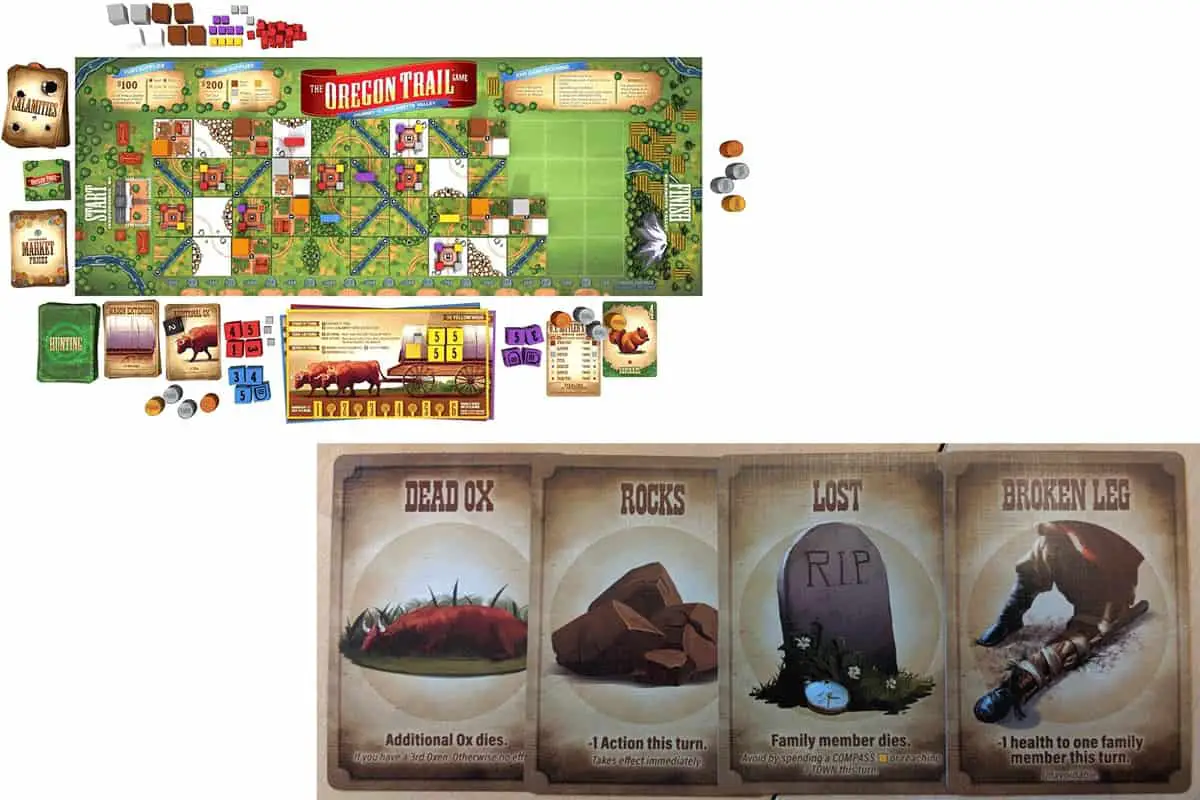
★★★★☆
Age: 13+ | 2-4 Players | Game Duration: 30-60 minutes | Designer: Daryl Andrews
From 1811 to 1840, the 2,170-mile Oregon trail was only passable on foot or by horseback. In 1836, the first emigrant wagon trail was organized in Independence, Missouri. This journey is depicted in The Oregon Trail: Journey to Willamette Valley, a competitive racing game for 2-4 players.
a competitive racing game for 2-4 players.
Each player represents a pioneer family in 1844 which travels in a cramped wagon and with an insufficient supply of food and money. They try to survive, picking up hitchhikers, overcoming obstacles (drowning, rattlesnakes, diseases, starvation…), hunting for food, buying food & medicine or spare parts, selling goods in the towns they cross.
The game ends when a player’s wagon reaches Willamette Valley, The player with the most points wins the game (based on the money they have, the remaining family members, hitchhikers etc…).
Oregon Trail makes a great work at simulating the Oregon trail journey.
Besides, it is very approachable, with rather straightforward rules (even if not always explained in great detail) that make it playable by most people. Also, luck plays the main role in the game (not really strategy), making it good with kids that are not especially strategy minded. All this makes it a good family game, and in my opinion explains its great commercial success.
The negative aspect though is that “Oregon trail” is not really what gamers would call a good game: your strategy does not matter very much, you are constantly struck by calamities, there is not much interaction between players. As Tom Vasel says, it could have been a cooperative game, and that would have made a ton of sense for a survival game, but it is not.
By The Dice Tower
Railroad Revolution (What’s Your Game)

★★★☆☆
Age: 12+ | 2-4 Players | Game Duration: 45-95 minutes
Railroad Revolution is a worker placement game inspired by the stiff competition of giant railway corporations across America in the 19th Century.
is a worker placement game inspired by the stiff competition of giant railway corporations across America in the 19th Century.
In this strategy game, 2-4 players represent owners of small railroad companies in the East. Their objective is to be recognized as the most powerful railroad company in America by expanding to the West.
Players must carefully select workers in 4 main actions to score victory points. They are:
- Building train stations
- Building or extending railroads
- Setting up telegraph offices
- Selling the company’s assets
Players can hire and remove workers. Workers that are promoted to managerial positions cannot be used anymore. The winner is the player with the highest victory points at the end of the game.
The components are appealing, but Railroad Revolution has not quite caught up.
on gaming-rules
Tesla vs. Edison: War of Currents (Artana)

★★★☆☆
Age: 14+ | 2- 5 Players | Game Duration: 90 minutes | Author: Dirk Knemeyer
Tesla vs. Edison: War of Currents was about the fierce competition of electric companies that introduced electric power transmission systems in the late 1880s.
was about the fierce competition of electric companies that introduced electric power transmission systems in the late 1880s.
This strategy game features historical inventors such as:
- Nikola Tesla
- Thomas Edison
- George Westinghouse
- Elihu Thomson
- Charles Brush
- Hiram Maxim
- And many more.
In this game, players represent one of these influential inventors and manage an electric company that runs AC or DC systems.
Players increase their company’s assets by:
- Recruiting people with special abilities
- Acquiring patents and electric projects all over America
- Investing in AC or DC technologies
- Manipulating the stock market and public perception through propaganda
The game is played over six rounds with three phases, and the player with the most value in shares at the end of the game is the winner.
Components-wise, they are neat and sturdy but unattractive. I recommend browsing the cards because they are packed with images and information about the inventors and their contributions.
However, there is one dominant strategy to win the game (buy and sell stocks), which makes the rest of the mechanics of the game a bit meaningless.
by Tom Vasel
Catan Histories: Settlers of America (Catan Studio)
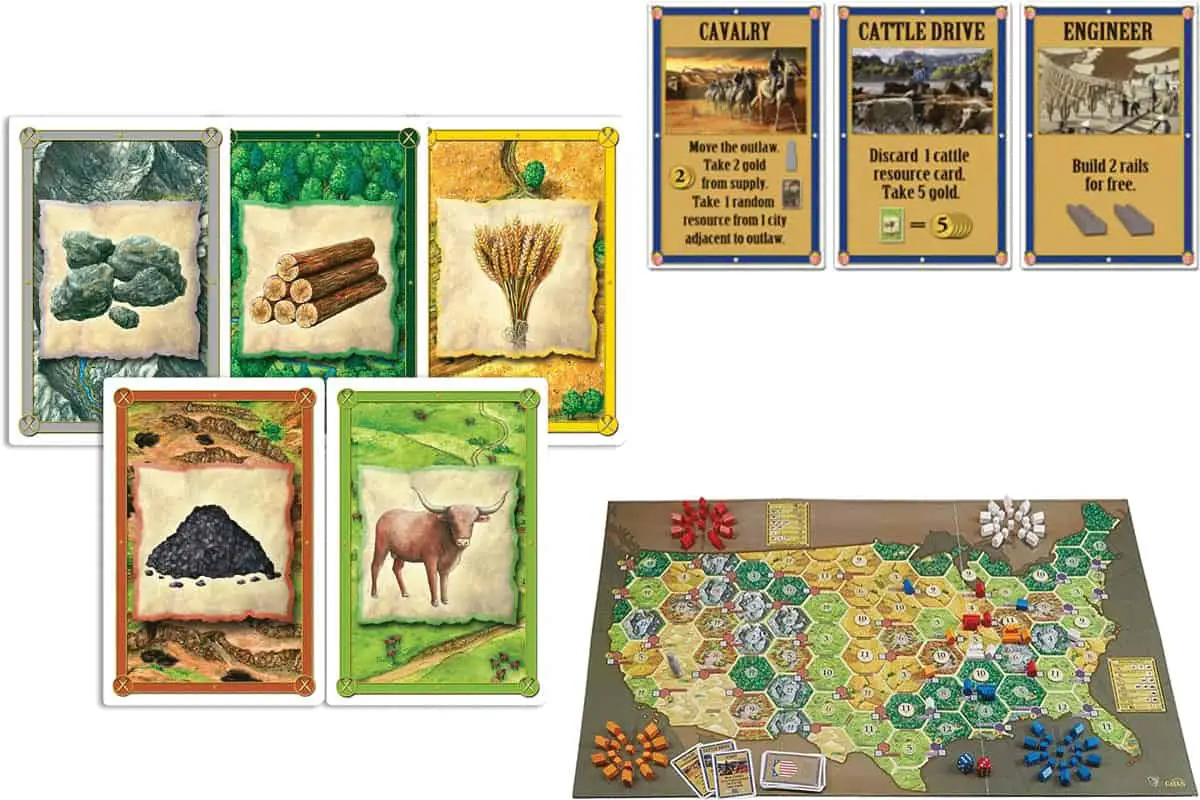
★★★☆☆
Age 12+ | 3-4 Players | Game Duration: 1-2 hours | Designer: Klaus Teuber
In Catan Histories: Settlers of America, players move westward to build new settlers, trains, railroads, and cities.
players move westward to build new settlers, trains, railroads, and cities.
This strategy game belongs to the very successful Catan games line – namely the Catan Histories line.
If you like Catan, and you are interested by the theme of American settlers, “Catan Histories: Settlers of America” will probably feel great, as it is similar to the regular Catan game but more sophisticated, and introduces the American Settlers theme.
But this sophistication is probably too much if you want to play with children, and the American settlers theme feels a bit like a pretext – with the game using trains as a twist for example, but not in a very convincing manner.
So as much as it can be great for a Catan fan, I would not recommend it if you expect educational value beyond the game mechanics.
how you can play Catan Histories: Settlers of America.
Founding Fathers (Sports Images, Inc.)
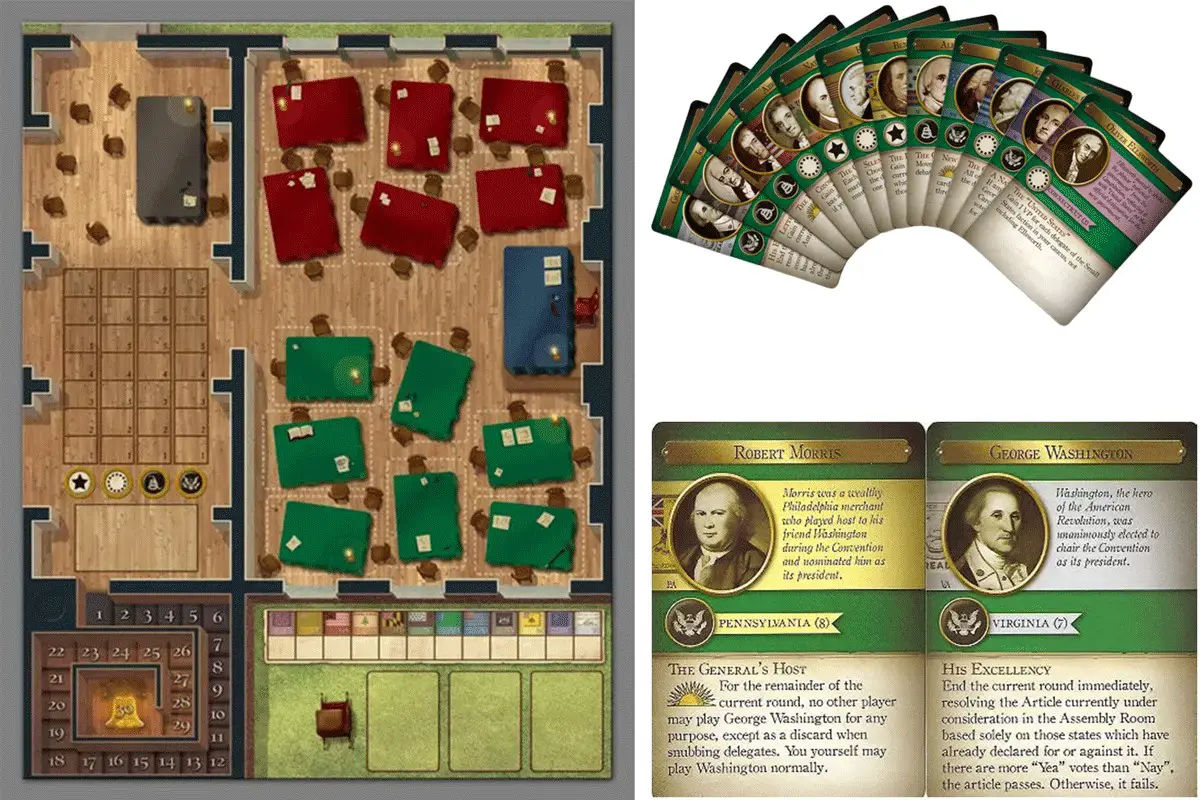
★★★☆☆
Age 13+ | 3-5 Players | Game Duration: 90 minutes | Designers: Christian Leonhard and Jason Matthews
An entertaining way to introduce politicians who crafted the US constitution is by playing Founding Fathers. In this card-driven game, 3-5 players represent delegates to the Constitutional Convention to approve or disapprove constitution articles in each round.
In this card-driven game, 3-5 players represent delegates to the Constitutional Convention to approve or disapprove constitution articles in each round.
The game’s goal is to become the founding father of the US Constitution by obtaining the highest victory points.
Players accumulate victory points by voting with the majority or debating on federalist/anti-federalist or big or small states issues.
At the start of the game, each player has a hand of 3 delegate cards. These cards represent their respective states, and they contain special abilities.
The game takes about 90 minutes because players have to read cards.
I like that:
- The cards and the 19-page rulebook are rich in easy-to-understand historical content. They contain images of the actual delegates to the Constitutional Convention.
- The color, design, texts, and artwork of the components are consistent with the historical theme of the game.
Game components include player reference cards, constitution article cards, delegate cards, tokens, and a gameboard.
However, the gameplay is competitive and difficult to explain to young players. If you give it a try, I suggest playing it with parents or adults to grasp the concepts of passing the articles and voting on issues and, hopefully, figure out the strategy to win the game.
You can browse the contents of the rulebook here .
.
to learn how to play Founding Fathers
We the People Fight the Tyranny (Constitution Games, LLC)

★★★☆☆
Age 15+ | 3-8 Players | Game Duration: 60-120 minutes | Designer: Robert Snizek and Brenda Snizek
We the People Fight the Tyranny is a roll, spin, and move trivia game where players must answer history questions correctly to earn stars.
is a roll, spin, and move trivia game where players must answer history questions correctly to earn stars.
The game’s goal is to be the player with the most stars when the first player runs out of starting cash.
This game consists of 500 multiple choice questions that are divided into five categories:
- Stubborn facts– contains interesting historical facts and explanation
- Portraits in Time– significant figures in American and world history
- In God, We Trust– includes America’s religious heritage, principles of faith, and scriptures
- Spoken Identity– statements made by influential political figures
- We the People– documents that shaped American history
It comes with a large gameboard, decks of cards, score pad, pawns, dice, and rules.
I like that:
- The cards are convenient to use
- There are options available
- The answer, explanation, image, and references are provided at the back of the card
- The texts are reader-friendly
- The instructions are easy to follow
The cons of the game include
- it takes about 1-2 hours to finish it
- The artwork combines actual images and cartoons, which I find messy.
- Includes satire, so parents should step in to explain
I recommend this game because children will learn interesting facts about American history and relevant political figures.
Freedom: The Underground Railroad (Academy Games)
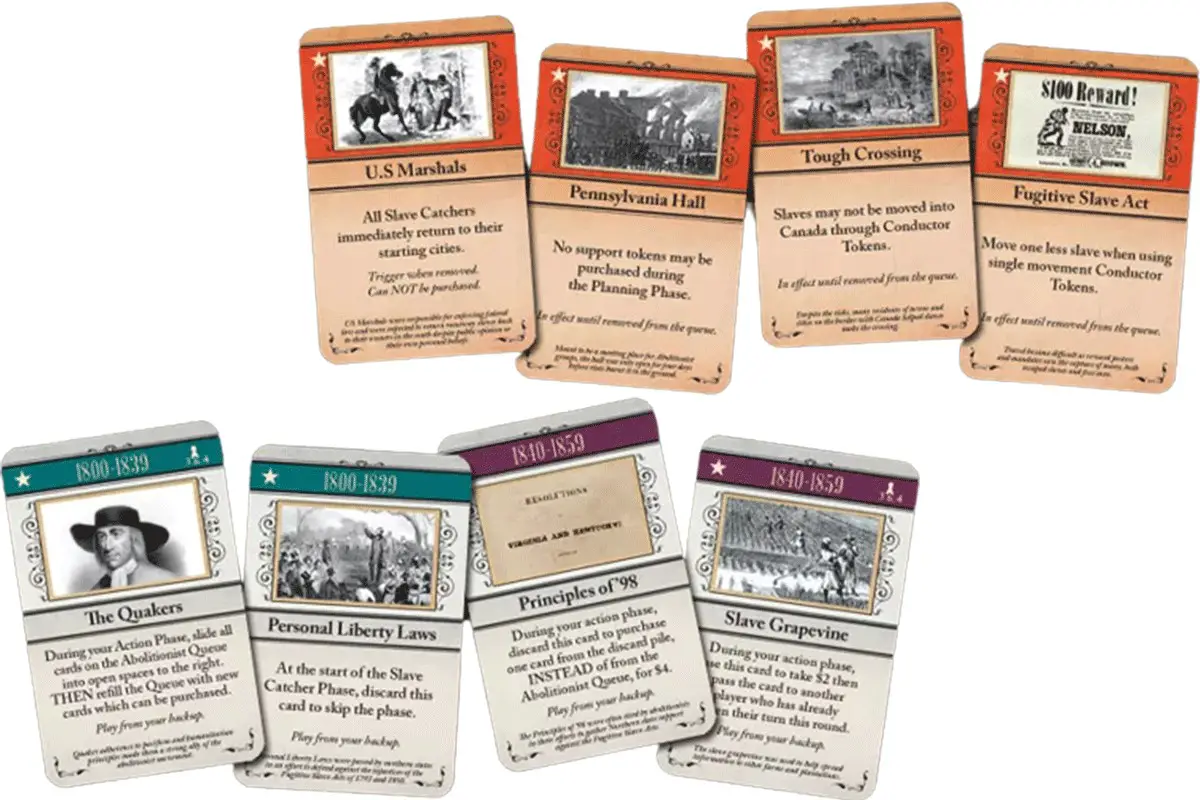
★★★★☆
Age 13+ | 1-4 Players | Game Duration: 1-2 hours | Designer: Brian Mayer
Freedom: the Underground Railroad is a cooperative game that teaches children about the significant events between 1800 and 1865 in America. It depicts how the Abolitionist movement succeeded in putting an end to slavery.
is a cooperative game that teaches children about the significant events between 1800 and 1865 in America. It depicts how the Abolitionist movement succeeded in putting an end to slavery.
In this game, 1-4 players are required to work together to raise funds and help enslaved people escape slave catchers as they move from the Southern States to Canada, where they can enjoy freedom.
At the start of the game, players select their Abolitionist role in the game. Then, they pay for action tokens to raise funds. These fund tokens are used to activate events or actions that free up enslaved people.
I recommend this game because:
- It offers high player interaction and engagement (Players can discuss strategies with each other and modify gameplay based on historical events)
- It has replay value because it has easy and hard settings
- Educational
- The rulebook provides a historical overview
- Players may familiarize themselves with historical figures and laws during that period
- Players learn about slavery and its brutality
- Has well-made components
- Clear directions
The only thing I find disappointing in this game is its gameplay length (it takes about 1-2 hours to finish). Playing this game with parents or adults at home will make the game experience more enjoyable.
Lessons about slavery and the abolitionist movement are considered hard history for middle school students, but this board game has a good approach to teaching these lessons.
This game is a good supplemental activity for 8th graders. That is why I am giving this game four stars.
Other Types of History Games
For more history games, kindly visit the following posts I created:
- 5 Board Games That Teach History

- 6 History-themed War Games

- 14 American History Card Games and Flash Cards for Families and Schools

- 18 Card Games That Teach World History for Families and Schools

- 7 Art History Board Games for School and Home

- 20 Memory Games To Teach Art and Art History

Edudingo.com is a participant in the Amazon Services LLC Associates Program, an affiliate advertising program designed to provide a means for sites to earn advertising fees by advertising and linking to Amazon.com. We also participate in other affiliate programs which compensate us for referring traffic.

